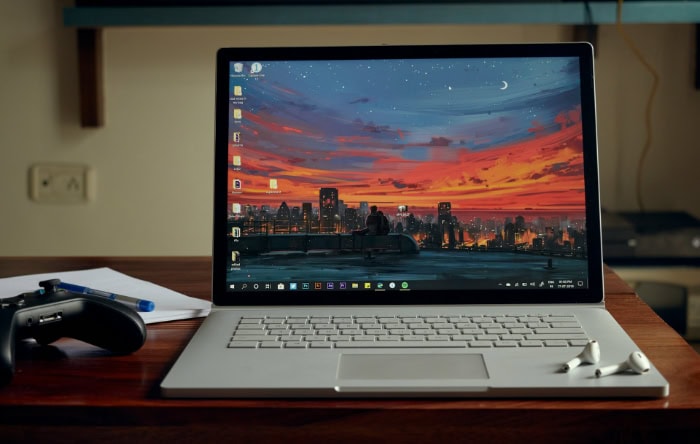Is Windows Defender Good Enough? Security Insights

Windows Defender has come a long way since its inception, transforming from a basic antispyware tool into a robust, full-featured security solution. As cyber threats evolve and multiply, the need for reliable protection has never been more critical.
Microsoft's built-in defender now stands as a formidable guardian against a wide array of digital dangers, from viruses and malware to sophisticated ransomware attacks. But does it offer enough protection for today's users?
Windows Defender's Arsenal of Protection
Windows Defender has evolved into a comprehensive security solution, offering a robust set of features to protect users from various digital threats.
At the forefront of Windows Defender's capabilities is its real-time protection against malware and viruses. This feature continuously monitors your system, scanning files and programs as they are accessed or downloaded.
By utilizing advanced algorithms and up-to-date threat definitions, Windows Defender can identify and neutralize potential threats before they can cause harm to your system.
The real-time protection extends beyond traditional virus detection. It also guards against spyware, ransomware, and other forms of malicious software that could compromise your data or system integrity.
This proactive approach significantly reduces the risk of infection and helps maintain a healthy computing environment.
Fortifying Your Network Defenses
Windows Defender includes an integrated firewall that acts as a barrier between your computer and potential threats from the internet. This firewall monitors incoming and outgoing network traffic, allowing you to control which applications can access the internet and which incoming connections are permitted.
The network security features go beyond simple traffic filtering. They also include intrusion detection capabilities, helping to identify and block suspicious network activity that could indicate an attempted attack.
This multi-layered approach to network security provides comprehensive protection against a wide range of network-based threats.
Advanced Threat Protection Tools
Windows Defender incorporates several advanced features to enhance its protective capabilities. SmartScreen is one such tool, designed to safeguard users from phishing attacks and malicious websites.
It analyzes web pages and downloaded files in real-time, warning users about potential dangers and preventing the execution of suspicious files.
Another notable feature is ransomware protection, which guards against one of the most prevalent and damaging forms of malware. This feature works by monitoring changes to files in protected folders, preventing unauthorized applications from modifying or encrypting important data.
Cloud-delivered protection leverages Microsoft's vast network of sensors and artificial intelligence to identify and respond to new threats rapidly. This feature ensures that Windows Defender remains effective against emerging malware strains and attack techniques, even before traditional virus definition updates are released.
Tackling Persistent Threats with Offline Scanning
For particularly stubborn malware that embeds itself deep within the system, Windows Defender offers an offline scanning option. Windows Defender Offline operates outside the normal Windows environment, allowing it to detect and remove rootkits and other persistent malware that might evade detection during regular operation.
This powerful tool can be crucial in recovering systems that have been compromised by sophisticated threats. By booting into a clean, controlled environment, Windows Defender Offline can thoroughly scan and clean the system without interference from active malware.
Optimized Performance and Seamless Windows Integration
Windows Defender's effectiveness as a security solution is not solely determined by its protective capabilities. Its impact on system performance and how well it integrates with the Windows operating system are equally important factors.
Efficient Resource Management
One of the primary concerns users have with antivirus software is its potential impact on system performance. Windows Defender addresses this concern through intelligent resource allocation.
By leveraging built-in Windows processes, it minimizes the need for additional background services that could slow down your computer.
During idle periods, Windows Defender performs more intensive scans and updates, ensuring that your system remains protected without interfering with your active work. When your computer is in use, it scales back its activities to prioritize your tasks, striking a balance between security and performance.
The software also employs adaptive scanning techniques, focusing more resources on areas of your system that are frequently accessed or modified. This targeted approach helps maintain a high level of security while reducing unnecessary scans of rarely used files or system areas.
Harmonious Windows Ecosystem
As a native component of the Windows operating system, Windows Defender benefits from deep integration that third-party solutions cannot match. This integration allows for smoother operation and more efficient use of system resources.
For example, Windows Defender can leverage the same file indexing system used by Windows Search, enabling faster scans without duplicating effort.
The tight integration extends to the user interface as well. Windows Defender's settings and controls are seamlessly woven into the Windows Security Center, providing a unified interface for managing all aspects of your system's security.
This cohesive approach simplifies the user experience, making it easier for both novice and advanced users to maintain their system's security posture.
Continuous Protection Through Automatic Updates
To combat the ever-evolving landscape of cyber threats, Windows Defender employs an automatic update system. This system ensures that your protection remains current without requiring manual intervention.
Updates are delivered through the same channels as other Windows updates, streamlining the process and reducing the risk of update failures or conflicts.
The update system goes beyond simple virus definition updates. It also includes improvements to the scanning engine, new heuristic detection methods, and enhancements to the user interface.
This comprehensive approach ensures that Windows Defender continues to evolve and improve over time, adapting to new threats and user needs.
Synergy with Advanced Windows Security Features
Windows Defender's integration extends to compatibility with other advanced Windows security features. For instance, it works in tandem with BitLocker, Windows' full-disk encryption tool, to provide layered protection for your data.
While BitLocker encrypts your files to prevent unauthorized access, Windows Defender scans those files to ensure they're free from malware.
Similarly, Windows Defender complements Windows Hello, the biometric authentication system. By securing the underlying system against malware that could potentially compromise biometric data, Windows Defender enhances the overall security provided by Windows Hello.
This synergy between Windows Defender and other Windows security features creates a comprehensive security ecosystem. Each component reinforces the others, resulting in a more robust and cohesive protection strategy for your system.
Measuring Windows Defender's Protective Prowess

The true value of any security solution lies in its ability to effectively detect and prevent threats. Windows Defender has made significant strides in this area, evolving from a basic antispyware tool to a comprehensive security suite.
Tackling Known and Emerging Threats
Windows Defender has demonstrated impressive capabilities in detecting and neutralizing both known and emerging threats. Its detection rates for established malware strains are consistently high, often matching or surpassing those of premium third-party antivirus solutions.
This performance is largely due to Microsoft's vast telemetry network, which allows for rapid identification and response to new threats.
For emerging threats, Windows Defender employs advanced heuristic and behavior-based detection methods. These techniques analyze the behavior of files and processes, allowing the software to identify potentially malicious activity even if the specific threat hasn't been cataloged.
This proactive approach is crucial in defending against zero-day exploits and newly developed malware.
Standing Tall Among Competitors
When compared to top third-party antivirus solutions, Windows Defender holds its ground impressively. In recent years, it has consistently scored high marks in independent tests, often achieving detection and protection rates comparable to well-established paid antivirus products.
One area where Windows Defender particularly shines is its low rate of false positives. This means it's less likely to mistakenly flag legitimate files or activities as threats, reducing unnecessary interruptions and potential system issues.
This balance of high detection rates and low false positives makes Windows Defender a reliable choice for many users.
Real-World Protection Scenarios
In real-world usage, Windows Defender proves its worth through comprehensive protection against a variety of attack vectors. It excels in preventing malware infections from web browsing, a common source of threats for many users.
The integrated SmartScreen feature adds an extra layer of protection by warning users about potentially malicious websites and downloads.
Windows Defender also performs well in scenarios involving email-based threats, such as phishing attempts and malicious attachments. Its real-time scanning capabilities help catch these threats before they can cause harm, even if a user inadvertently clicks on a suspicious link or file.
For more sophisticated attacks, such as fileless malware or script-based threats, Windows Defender's behavior monitoring comes into play. It can detect and block unusual system behaviors associated with these advanced threats, providing protection even against some of the most cutting-edge attack techniques.
Addressing Limitations and Challenges
Despite its strengths, Windows Defender does have some limitations. One area where it may fall short compared to some premium antivirus solutions is in offline detection capabilities.
While Windows Defender Offline provides a powerful tool for removing persistent threats, its effectiveness can be limited if the threat definitions aren't up to date.
Another challenge lies in handling some types of advanced threats. While Windows Defender has made significant improvements in this area, some specialized third-party solutions may offer more comprehensive protection against targeted attacks or highly sophisticated malware.
It's also worth noting that Windows Defender's effectiveness can vary depending on how up-to-date the Windows operating system is. Users who delay system updates may find themselves more vulnerable to newer threats, as these updates often include crucial security improvements for Windows Defender.
Tailoring Windows Defender to Diverse User Needs

Windows Defender's versatility caters to a wide range of users, from individual home users to large enterprises. Its adaptability to different user profiles, ability to address specific security needs, and customization options allow it to meet varying risk levels and requirements across different computing environments.
Protecting Personal Computing Environments
For home users and personal computing, Windows Defender offers a robust and user-friendly security solution. Its seamless integration with Windows makes it an ideal choice for those who prefer a hassle-free approach to cybersecurity.
The automatic updates and real-time protection ensure that users are guarded against common threats without requiring constant attention or technical expertise.
Windows Defender's built-in features, such as parental controls and safe browsing tools, provide additional layers of protection for families. These features help create a safer online environment for children and less tech-savvy users, making Windows Defender a comprehensive solution for household computing needs.
Moreover, the absence of subscription fees or complex licensing makes Windows Defender an attractive option for budget-conscious home users who still want reliable protection. Its low system impact also ensures that personal devices remain responsive, even during scans or updates.
Securing Small and Medium Business Operations
Small to medium-sized businesses (SMBs) often face unique cybersecurity challenges, balancing the need for robust protection with limited IT resources and budgets. Windows Defender addresses these concerns by providing enterprise-grade security features without the complexity or cost typically associated with dedicated business security solutions.
For SMBs, Windows Defender's centralized management capabilities through Microsoft Endpoint Manager are particularly valuable. This allows IT administrators to deploy, configure, and monitor security settings across multiple devices from a single dashboard.
The ability to set group policies and enforce security standards helps maintain a consistent security posture across the organization.
Windows Defender's integration with other Microsoft business tools, such as Office 365 and Azure, creates a cohesive security ecosystem. This integration is especially beneficial for SMBs that rely on Microsoft's cloud services, as it provides seamless protection across both local and cloud-based assets.
Meeting Enterprise-Level Security Demands
In enterprise environments, Windows Defender takes on an expanded role as part of Microsoft's broader security ecosystem. While it continues to provide core antivirus and anti-malware protection, its capabilities are significantly enhanced when combined with other Microsoft security products.
Windows Defender Advanced Threat Protection (ATP), now part of Microsoft Defender for Endpoint, offers advanced features crucial for large-scale deployments. These include endpoint detection and response (EDR), automated investigation and remediation, and threat analytics.
Such features enable enterprise security teams to detect, investigate, and respond to sophisticated threats across their network.
The integration with Azure Sentinel, Microsoft's cloud-native security information and event management (SIEM) solution, further extends Windows Defender's capabilities. This allows enterprises to correlate security data from various sources, including Windows Defender, for comprehensive threat intelligence and incident response.
Conclusion
Windows Defender has evolved into a formidable security solution, offering robust protection against a wide array of digital threats. Its strengths lie in seamless integration with Windows, minimal system impact, and continuous updates leveraging Microsoft's vast threat intelligence network.
For most home users and small businesses, Windows Defender provides ample protection without the need for additional antivirus software.
However, Windows Defender is not without limitations. Advanced users or organizations facing sophisticated, targeted threats may find its features somewhat lacking compared to specialized security suites.
In such cases, supplementing Windows Defender with additional tools or opting for more comprehensive security solutions might be advisable.
For personal computing and general business use, Windows Defender stands as a solid choice. Its real-time protection, firewall capabilities, and cloud-based threat detection offer a strong defense against common malware and cyber attacks.
Small to medium-sized businesses can benefit from its centralized management features and integration with other Microsoft services.
Larger enterprises should consider Windows Defender as part of a broader security strategy. When combined with advanced features like Microsoft Defender for Endpoint, it can provide enterprise-grade protection.
However, these organizations may also need to invest in additional security measures to meet specific compliance requirements or counter highly sophisticated threats.
Regardless of the chosen security solution, user education remains crucial. Even the most advanced security software cannot completely protect against human error or lack of cybersecurity awareness.
Regular training on recognizing phishing attempts, practicing safe browsing habits, and understanding the importance of software updates can significantly enhance overall security posture.


